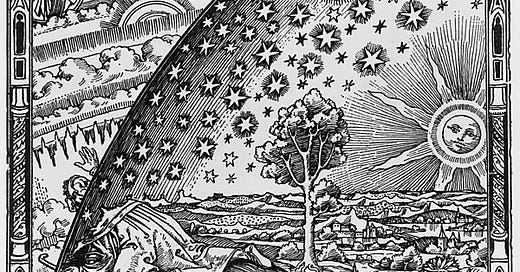From the time of Aristotle through the Middle Ages, science was natural philosophy. It was an amalgam of diverse ways of understanding, fitted to diverse observations about the world, trying to make sense of phenomena with whatever stories seem most appropriate to each situation.
Beginning with the enlightenment, the idea of “laws of nature” came into currency. Scientists came to see themselves as tapping into a universal order. There was a culmination in the 19th century of the view that
There is an objective world and the nature of that world is physical material — atoms.
There are universal laws, no exceptions, that are the same everywhere and for all time. Fixed laws govern the behavior of matter, and matter is all there is.
The nature of these laws is microscopic, and our understanding is therefore reductionistic. In other words, everything is made of atoms, atoms behave predictably, and everything from chemistry to sociology is potentially understandable as the collective behavior of atoms.
Science explains everything. There is no room for religious or mythical understandings. “God is dead,” Nietzsche declared.
Then, in the 20th century, a funny thing happened. Atomic physics, which was supposed to be the foundation of all science, was led by experiment to four fundamental contradictions of what had just recently become the “scientific worldview”.
Determinism was falsified. There are only probabilities at the microscopic level, and you can’t predict the future from what you know of the present, except as a set of probabilities for each outcome.
Reductionism didn’t work. In quantum mechanics, separate particles don’t have separate wave functions (probability functions). It’s all one big wave function, tying together all particles everywhere. (This is “entanglement”. It doesn’t just apply to pairs of identical particles that were once together but are now separated; it applies to everything.)
As soon as you get past two particles, the equations become so complicated that we can’t solve them, not even on the biggest computers or the biggest conceivable computers.* We can compute a hydrogen molecule with good precision, because it has only two elections. But something as basic as a single molecule of water can only be understood in an approximate, heuristic way, making assumptions that are validated after the fact by observations of actual water molecules.
The biggest hole in science was carved by the discovery that the world is not an objective material thing, but reality is co-created by the existing probability functions and the observer who measures them. Reality is essentially subjective.
This last radical idea — that reality is partially subjective — was understood early by Max Planck and Niels Bohr, the grandfathers of quantum mechanics; but it was the subject of vigorous debate until 1964, when John S Bell proved that it is an inescapable consequence of accepted quantum mechanical theory, now validated by experiment and honored with the 2022 Nobel Prize.
Science today is in a fragile state, a transitional state. On the one hand, there is no disputing these four consequences of quantum mechanics. On the other hand, the 19th century reductionist paradigm is so entrenched in our thinking that we find it too baffling, too disorienting to think in the new way. We are like Wile E. Coyote who has run off cliff but doesn’t doesn’t yet realize that there is no land underneath him.
There is a fifth discovery in the twentieth century, independent of quantum mechanics. Experiments in parapsychology advanced to a level of rigor and an accumulation of statistical data that prove conclusively: living things acquire knowledge in ways that defy present day science. There is telepathy — information transmitted between minds with no known sensory path that can explain how it is received. And there is precognition, in which our physiology (animals, too) respond to events that have not yet happened. These abilities challenge the notion that science is a hierarchy with physics at the foundation, and that biology can be understood as applied physics and chemistry.
All of experimental science is designed and interpreted on the assumptions
that there is an objective reality,
that the whole universe obeys fixed laws (the Zeroth Law of Science),
that it’s possible to isolate the experimental apparatus from outside influence,
and that the future can’t affect the past.
These assumptions have taken us a long way. They have served us well for 300 years, so we can assume that in some circumstances they have been a good approximation.
But they are not true.
There are only a handful of people in the world thinking about how to do science without making these assumptions, assumptions that our best science has falsified decades ago.
The world is subjective and connected. Science will have to redefine itself and its methods. Scientific culture and institutions will have to change in response. A new and ancient universe will unfold before us when we look upon it with new eyes.
Groping toward a scientific future
Let’s challenge ourselves to imagine (at least) the first steps toward a post-material, post-objective science.
Reproducibility has been the gold standard for validating scientific results, but, going forward, we must admit the possibility that two different experimenters might legitimately find different results when conducting the same experiment. We might begin to catalogue these differences, separate errors of technique and observation from the unavoidable, irreducible differences that come from the “experimenter effect”. For example, we suspect that the experimenter effect is stronger for biological than for physical experiments. Can we go further and quantify the reliability of replication in different kinds of experiments? Can we characterize the kinds of experiments that are most and least subject to the experimenter effect?
We might experiment with retrocausal influences on experimental results. Perform the identical experiment in labs A and B, but randomly assign in advance one of the two experiments to be influenced by a group of meditators, focusing their intentions after the experiment is completed. This protocol highlights the paradoxes of retrocausality and of subjective influence, and might be a fertile platform for exploring the limits of present-day methodologies.
There are individuals who seem to be especially gifted at the art of influencing reality with their thoughts. The quantum pioneer Wolfgang Pauli and the “PK man” Ted Owens seem to be examples. Perhaps we can learn from shamans and from Buddhist monks who have persistently trained their concentration.
There is already a rich database of scientific results based on energy healing, animal and plant communication, and transference of human intention into material objects. Water seems to be an ideal vehicle for carrying subtle, mental effects into physical experiments. The conventional science community should be embracing these results and looking for ways to understand current paradigms in order to understand them.
————————
* Quantum computers may someday be an exception.





Water seems to be an ideal vehicle for carrying subtle, mental effects into physical experiments. The conventional science community should be embracing these results and looking for ways to understand current paradigms in order to understand them.....
Precisely and yet science-medicine, in general, totally rejects Homeopathic medicine which has been demonstrating such realities for more than two centuries.
There is a particular level of hubris and arrogance in science and medicine when they reject out of hand modalities they do not understand simply because they cannot be fitted into materialist reductionist science.
I wonder how far the retrocausal influence might extend?
And example that occurred to me: assemble two statistically large sets of otherwise very similar telescope data. There are vast troves of such data available online. Divide it into two samples, one of which will be focused on by meditators after the analysis is complete. The analysis could be intended to find e.g. a certain type of stellar variability, pulsations for example. The meditators would focus on just that form of variability. Is it found with greater frequency in the sample they focused upon? If so this would be curious indeed, as the light from those stars left many hundreds or thousands of years in the past....